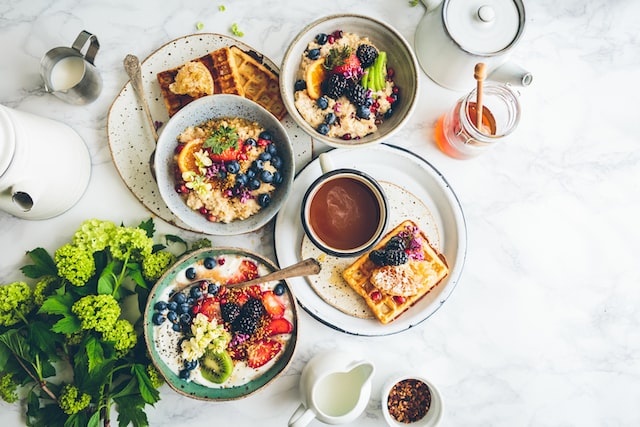There is a strong empirical base to support intuitive eating as an adaptive alternative to dieting. A meta-analysis of 97 studies found that intuitive eating was inversely associated with eating pathology indices, body image disturbances, and psychopathology (Linardon et al., 2021). Furthermore, intuitive eating is associated with positive psychological constructs that include self-esteem, improved body image, and improved overall reported well-being (Linardon et al., 2021).
Intuitive eating, however, is not without its challenges. As a registered dietitian, one of the most common sentiments I hear is, “now that I’ve started intuitive eating, I feel like I’m buying into diet culture if I choose something based on nutritional value.”
Goodness, when people start to adopt intuitive eating, it’s easy to feel resentful towards the idea of nutrition. After so many years of feeling like you can’t get it right, intuitive eating can be a needed pause from the loud inner critic that tells you never choose the “right” foods, the “healthy” foods, or the “nutritious” foods. Healing from binge eating, restricting, and weight cycling is already a difficult process, and nutrition may feel like the last thing you want to think about. It makes sense, and this is why typically, we don’t introduce gentle nutrition until people feel comfortable with some of the other principles of intuitive eating first: honoring your hunger, discovering satisfaction, feeling your fullness, and respecting your body. If you’re healing from a lifetime of chronic dieting, focusing on nutrition can feel punishing.
How do we distinguish between gentle nutrition and diet culture? How do we know when we are ready to let nutrition be one of the principles that guides our food choices?
Intuitive Eating and Gentle Nutrition vs. Diet Culture
Let’s start by defining diet culture. Christy Harrison (2018), author of Anti-Diet and prominent member of the Intuitive Eating community, defines diet culture as, “a system of beliefs that… demonizes certain ways of eating while elevating others, which means you’re forced to be hypervigilant about your eating, ashamed of making certain food choices, and distracted from your pleasure, your purpose, and your power.” Said differently, diet culture is an absolutionist way of thinking about and interacting with food. Some foods are allowed, others are not, and choosing foods in the latter category reflects your morality. Americans rank number one for worry over diet and nutrition, and to no surprise, they also experience great dissatisfaction with their food choices (Tribole & Resch, 2012).
Enter: gentle nutrition. Gentle nutrition is a term first employed by Evelyn Tribole, MS, RD and Elyse Resch, MS, RD, CEDS (2012) in their seminal book Intuitive Eating. Gentle nutrition is one of the ten principles of intuitive eating, and a way to honor your health and show your body respect and affection, rather than a way to punish yourself. While diet culture dictates your food choices against your wishes, gentle nutrition can help as one clue to help guide you to what you might choose to eat. Diet culture strips personal autonomy, gentle nutrition simply providers us with some data that may or may not sway our food choices. We might think of gentle nutrition as a place that exists in the intersection between our nutrition knowledge and our body’s desires. It takes into account both our internal cravings as well as the external messages we have learned about honoring our health.
How do I know the difference between diet culture and gentle nutrition?
To illustrate the difference, let’s use an example.
Diet culture influenced train of thought:
“I’m in the mood for pizza, but my marathon is coming up, and I need to make sure I’m at my race weight. Is that too many carbs? I had a big lunch, so I probably shouldn’t have something with so many calories in it. Maybe I will have the pizza, but I’ll lengthen my run tomorrow to burn off the extra calories.”
Gentle nutrition influenced train of thought:
“I’m in the mood for pizza. I’ve got a frozen one on hand already, that could work well for tonight since I’m short on time. Plus the pizza will be a good way to get carbs in for my run tomorrow. I haven’t had much color in my day today, so maybe I’ll add a salad with chickpeas and the rotisserie chicken I have in the fridge to give me some extra protein, fiber, and color, plus I don’t want to feel bloated the way I might if I only have the pizza, especially since I’ve got a long run tomorrow. I’ve got a big week of mileage, and I want to make sure I’m getting the nutrition I need so I can fuel and recover.”
As you can see, the first scenario is almost exclusively driven by external cues: amount of carbs, amount of calories, desire to achieve a certain weight. The second scenario is driven by a mix between internal and external cues:
- The craving for pizza
- The attention to our need for carbohydrates in order to fuel activity
- The knowledge that certain foods, such as protein and fiber, help us feel good and function better—reduce bloating, constipation, and increase muscle recovery
- the understanding that we need vitamins and antioxidants that come from colorful foods such as fruits and vegetables in order to recover from the inflammatory process that accompanies exercise
- The desire to fuel adequately for activity by eating ENOUGH

How do I know when I’m ready for gentle nutrition?
In order to make peace with food, we do often need to temporarily put nutrition on the back burner, because in the early stages of unlearning diet culture, gentle nutrition can feel like another food rule. In the early stages, the process of neutralizing our view of food, a key ingredient to food freedom, can be clouded by nutrition advice.
As you move further into your food freedom journey and you feel that you’ve made some headway on decoupling food choices from morality, here are some indicators you might be ready to implement gentle nutrition:
- You have gotten to a place where you feel less anxiety about eating foods that once made you feel guilty and shameful
- You don’t find yourself persistently fighting the urge to restrict your intake
- You no longer feel like you’re fighting the urge to binge every time you’re around a food that was once “forbidden”
- You no longer feel like you need to “compensate” when you eat a heavier meal
- Have I achieved some level of weight neutrality in my perspective about my body?
Okay, I think I’m ready for gentle nutrition. Now, how do I begin?
If you feel like most of these conditions apply, it can be helpful to begin with some simple observation: how do different foods affect me? For example, you might find you’re satisfied with just a smoothie on days you’re working from home, but on days you go to the office and have a more dynamic schedule, the smoothie may not be quite enough to keep you full. This may be a chance to add something that we know has components that contribute to satiety: perhaps adding two hardboiled eggs on the side to add additional protein and fat, or a side of oatmeal cooked in milk for additional fiber. Recording your observations in a journal or note on your phone can help you keep track of them.
Another great rule of thumb when starting to incorporate gentle nutrition is to think about what you can add, rather than what you can remove. What could you add to lunch to give it a bit more nutrient density? Is there snack that you feel like you could add something with color?
Ask yourself, what do you need to make your meals a little more nutritious? Would doing some meal planning help you to think ahead and allow you to have the items you need on hand when you are in the mood for a nutritious meal. Perhaps a trip to the farmers market could give you some inspiration if you feel like you’re cooking the same meals over and over again, and you’re getting bored.
The bottom line on gentle nutrition in intuitive eating
The most important differentiator between gentle nutrition and diet culture is nurturance. Above all else, gentle nutrition is step in the direction of self-care, not self-control. If your gentle nutrition choices are causing you stress and torment, we might need to re-assess! If you are struggling with your eating dieticians are here to help.
References
Linardon, J., Tylka, T. L., & Fuller‐Tyszkiewicz, M. (2021). Intuitive eating and its psychological correlates: A meta‐analysis. International Journal of Eating Disorders, 54(7), 1073–1098. https://doi.org/10.1002/eat.23509
Tribole, E., & Resch, E. (2012). Intuitive eating. St. Martin’s Griffin.
Both of our dietitians, Morgan and Kelly, work with clients on intuitive eating. It is very difficult to work on intuitive eating alone without support. You can learn more about nutrition support Morgan and Kelly provide at: nutrition counseling services.
Thank you Caroline for this blog post
Guest Blog Post by Dietician Carolyn Burkholder
Caroline Burkholder is a registered dietitian nutritionist licensed in Georgia, Maryland, and Tennessee, and the owner of RootED Nutrition + Counseling. Caroline is a weight inclusive, trauma informed, health at every size aligned dietitian. Her evidence-informed work is influenced by intuitive eating, body neutrality, feminist theory, and mindfulness practices. She has undergone specialized training in Eating Disorders, Family Based Treatment (FBT), Acceptance and Commitment Therapy for dietitians, and Radically Open DBT for dietitians. Prior to founding RootED Nutrition and Counseling, she worked in university counseling, residential mental health treatment, and in group practice.
















